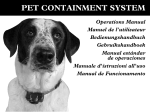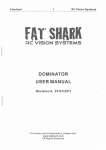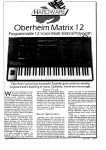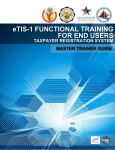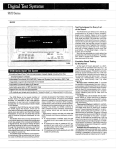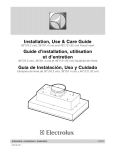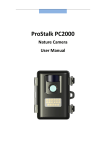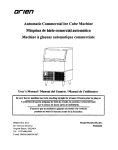Download Code Alarm 2000 Specifications
Transcript
INTRODUCTION Congratulations on your purchase of a DSC PC2000 Burglar Alarm Control system. The PC2000 has been designed to give you the greatest possible flexibility and convenience in the use of your security system. This booklet is intended to serve as a handy reference and should be kept in a secure place. Your security system consists of a number of different components. One component is the DSC PC2000 control panel which will be mounted out of the way in a utility room or basement. In addition to the main control electronics, the control panel contains the standby battery and system fuses. There is normally no reason for the user to have to access the control panel. The system also has one or more keypads which will be mounted in convenient areas close to the exit-entry doors. The keypads provide complete information about, and control of, the security system. The security system has up to eight zones or areas of protection. Each zone will be connected to one or more detection sensors such as door or window contacts, motion detectors, glass break detectors or vibration or shock sensors. The keypad zone lights are on when any sensor is activated. The label provided for the inside of the keypad door can be used to record which sensors are on each zone. 9 . _‘. 4 IMPORTANT NOTICE Digital Security Controls Ltd recommends that you read this manual carefully and become familiar with the operation of your security system. Check with the installing company to see which commands listed in this manual apply to your particular security system. Fill out the system reference sheet and store this booklet in a secure place for future reference. It is important to test your system on a regular basis. To do this, first inform the monitoring station that you are testing your system. Then, with the system disarmed, activate all detection sensors one at a time and observe the zone light come on at the keypad as each sensor is activated. Perform a bell test by using the [x] 14) command. The PC2000 can be programmed at the time of installation to automatically perform a test transmission to the monitoring station on a regular basis. If this has not been done, check with the monitoring station for instructions on how to perform a test transmission. Check to see if the ‘TROUBLE’ light is on when arming the system and contact the monitoring station if the trouble conditon cannot be cleared. , ’ .’ - . SYSTEMREFERENCE Zone Number Protected Area 1 2 3 4 6 8 Keypad Zone [1].[3] Keypad Zone [ *].[#I Master Code Number Programmed Code Numbers Monitoring Stalion Information Account # Telephone # Notes PRINTED IN CANADA COPYRIGHT 1966 DIGITAL SECURITY CONTROLS LTD. 1645 FLINT ROAD, DOWNSVIEW. ONTARIO CANADA M3J 2J6 Zone Type MASTER CODE The master security code is a 4 digit code which is supplied at the time of installation. The master code is entered from the keypad and is used for arming and disarming the security system, for programming additional security codes and for changing other features. All keypad entries are made by pressing only one key at a time, with exception of “KEYPAD ZONE” activation. z ‘. ARMING .d* Close all protected doors and windows and stop movement in areas covered by motion detectors. If ‘SHUNT’ light is on, be sure zones are being intentionally by-passed before arming the system (see ZONE BY-PASSING). Check to see that the ‘READY’ light is on (all zones are closed). The system cannot be armed unless the ‘READY’ light is on. Enter a [4 digit security code]. As each digit is entered the keypad sounder will beep. The ‘ARMED’ light will come on and the keypad sounder will beep quickly. If the security code was entered incorrectly or the ‘READY’ light was not on, the keypad sounder wilt beep steadily for 2 seconds. When the correct code is entered and the system is armed, exit the premise through the designated exit-entry door. At the end of the allowed exit time all lights on the keypad will go out except the ‘ARMED’ light. See the “PROGRAMMING OTHER SYSTEM FEATURES” section for instructions on how to change the allowed exit time. Also see, QUICK-ARM and AUTO-ARM. DISARMING Enter the premise through the designated exit-entry door. The keypad sounder will be on. Go to the keypad and enter the [4 digit security code]. If an error is made in entering the code, press the [#] key and enter the code again. The ‘ARMED’ light will go out and the keypad sounder will stpp. The correct security code must be entered before the allowed entry time expires. To change the entry time see “PROGRAMMING OTHER SYSTEM FEATURES”. If an alarm occured while the panel was armed, the ‘MEMORY’ light and the ‘ZONE’ light which caused the alarm will start to flash and stay flashing for 30 seconds. ZONE BY-PASSING (SHUNTING) Shunted zones do not cause an alarm. Use zone shunting when access is needed to part of the protected area. Also, damaged wiring or contacts on a zone may be temporarily shunted until repairs can be made so that the panel can be armed. ’ To shunt zones, enler [ *I,[ 11 and the zone number(s) to be shunted. To remove all shunts, enter [*],[l],[O]. The ‘ZONE’ lights which are on indicate shunted zones. Press [#) to return lo ‘READY’(arm/disarm mode). When the system is installed, the abilily to shunt certain zones may be eliminated. In this case, the ‘ZONE’ lights for those zones will not come on in response to the shunt command. The ‘SHUNT’ light is on as long as at least one zone is shunted. Do not unintentionally shunt zones when arming. Zone shunts are cancelled when the panel is disarmed. TROUBLE DISPLAY The PC2000 continuously monitors a number of possible trouble conditions. If one of these conditions occurs, the keypad ‘TROUBLE’ indicator will light. Press the [XC] then [2] keys to display the type of trouble. The ‘ZONE’ lights indicate the type of trouble condition. I- DEFECTIVE STANDBY BATTERY 2- AC POWER FAILURE 3- BLOWN FUSE IN CONTROL PANEL 4- TELEPHONE LINE PROBLEM 5- UNSUCCESSFUL COMMUNICATION ATTEMPT WITH MONITORING STATION 6- not used 7- BELL/SIREN CIRCUIT DEFECTIVE 8- MEMORY LOSS (USE MASTER CODE TO REPROGRAM) Press the [#] to return to ‘READY’. ALARM MEMORY DISPLAY If the ‘MEMORY’ light is on an alarm has occured. The memory will be cleared when the panel is re-armed. Press the [*I then [3] keys to display which zone caused the alarm. Press [#] to return to ‘READY’. . ARMED light will come on indicating system armed. Ensure READY light on, enter 4 digit code. MEMORY light on means an alarm has occurred To display zone that caused alarm, press @I then &I. Zone light will come on indicating which zone caused alarm. ZONE light(s) when on in the normal operating mode indicate an open zone. eg: open door, window, etc. Refer to zone chart on keypad door for detailed zone information. SHUNT light will come 1 on when you by-pass a zone. To by-pass a zone, press 63 then ci3 and then the zone(s) you wish to by-pass. Press @I to return to ready. r TROUBLE light on means there is a fault on the system. Press &I then q to display trouble type: 1. Battery 5. Communicator 2. A.C. Power 6. Not used 3. Fuse 4. Telephone line 7. Siren circuit 6. Power up c I Program PROGRAM light is on when you pro ram user codes. Press PI * then @ then enter Master Code, program light will come on. Select which code you wish to program 1 thru 8, then enter 4 digit code. Press •I to return to ready. Program light must be “on” to add or change user codes. Ready tliht must be on. Enter code ZONE BY-PAStNO: Press @ then CT] keys. Presszones to be by-passed. Press @ to return to ‘Ready’. AURM MEMORY: i’ms.s &I then @j. P@-MMMIN6 CODES: Enter QD @I. master code 1 to 8 and new 4 dldt code. ’ KS SYWEht FltEQtJE~y Key pad door has zone identification and basic user instructions. Protects keypad when keypad not in use. ALARM TEST Press I*] lhen [4] for a 4 second lest of the keypad lights, keypad sounder and sirens. This is a local lest only. A lest transmission to the monitoring station is not done with this command. PROGRAMMING ADDITIONAL SECURITY CODES Enter [*I&] and [master security code]. The ‘PROGRAM’ light will flash and the ‘ZONE’ lights will show which codes have already been programmed (up to 8 codes can be programmed from the keypad). Press any key from (1 to 81 to indicate which one of the 8 codes is being programmed. The ‘ZONE’ light will flash to indicate which code is being programmed. Enter a [4 digit security code]. At this point if [ * JC * xc] instead of a [4 digit code] is entered, any previously programmed code in this localion will be eliminated. To review: programming a new code; enter [*]$$[master code],(l to 8],[4 digit code]. eliminating an existing code; enter [*],[5].[master code].[l to S],[xx-x-x] Press [#] to return to ‘READY’. SETTING AUTOMATIC ARMING TIME The PC2000 can be programmed to automatically arm each day at the same lime. To set the lime, enter (~1, (61 and a (4 digit security code]. Then enter any [two digits] (from 01 to 23) for the number of hours until arming is to take place. For example if it is 3:00 pm and auto-arming is to take place at 8:00 pm enter 05 for the five hours between 3:00 pm and 8:00 pm. ,.. * _ -” Press [#] to return to ‘READY’. ... The [-K] [S] command is only used to set the arming time. The [x] [8] command is used to turn on and off the auto-arm feature. See “PROGRAMMING OTHER FEATURES”. SPECIAL FUNCTION COMMAND The PC2000 can be programmed at the time the system is installed to operate other devices such as electric door strikes, door openers, electric lights, cameras, etc. by a command from the keypad. This special function is activated by pressing [s] then [7]. PROGRAMMING OTHER SYSTEM FEATURES Before any of the following functions can be programmed, enter [*I, [8] and [master code]. The ‘PROGRAM’ light will be flashing. Press [l] then enter any [two digits] (from 01 to 99) to set the “ENTRY TIME” in seconds. The “ENTRY TIME” is the time allowed between opening the exit-entry door and entering the security code to disarm the PC2000. Press [2] then enter any [two digits] (from 01 to 99) to set the “EXIT TIME” in seconds. The “EXIT TIME” is the time allowed between arming the PC2000 and exiting the exit-entry door. Press [3] then enter any [two digits] (from 01 to 99) to set the “ALARM CUT-OFF TIME” in minutes. The “ALARM CUT-OFF TIME” is the length of time the siren or bells will ring before shutting off. Press [4] to turn on the “QUICK-ARM” feature. The keypad sounder will beep quickly 3 times. The “QUICK-ARM” feature allows entering [*I then [O] to arm the PC2000 in place of a [4 digit code]. [x] [0] will not disarm the PC2000. Pressing [4] again will turn off “QUICK-ARM”. The sounder will give one long beep. Press [5] to turn on the “AUTO-ARM” feature. The sounder will beep 3 times. The “AUTO-ARM” leature arms the PC2000 at the same time each day. The keypad sounder starts one minute before the programmed arming time (see [ *] [6] command for programming “AUTO-ARM” time). The arming sequence may be stopped by pressing any key. At the end of one minute the PC2000 will be armed. Pressing [5] again will turn off “AUTO-ARM”. The sounder will give one long beep. Press [S] to turn on the “ALERT” feature. The sounder will beep 3 times. The “ALERT” feature is used, while the panel is disarmed, to provide a tone from the keypad each time a door or window is opened or closed. The specific doors and windows which provide indication are determined at the time of installation. Pressing [S] again will turn off the “ALERT”. The sounder will give one long beep. AUTO-TEST TRANSMISSION The PC2000 can be programmed, at the time of installation, to send a test code to the monitoring station at regular intervals. The frequency and time of test transmissions is set by the monitoring station and should not be changed without their knowledge. DURESS CODE The duress code feature must be programmed into the PC2000 at the time of installation. When the duress code is used instead of a normal security code for disarming, the system disarms as normal but a special duress code is sent to the monitoring station. A duress code is created by adding 1 to the last digit of any valid security code. When the duress code feature is used, the master security code and the programmed security codes must not end in a 9. Also. avoid programming a new security code which is the same number as another duress code. This may cause a duress code to be transmitted when the new code is used. 1234 Example: if normal security code is then duress security code would be 1235 KEYPAD ZONES There are two zones which can be activated from the keypad. One keypad zone is activated by pressing the [l] and [3] keys at the same time. The siren/bell output from this zone pulses on and off. This zone is annunciated by the ‘ZONE 7’ light on the keypad. The other keypad zone is activated by pressing the [x) and I#] keys at the same time. This zone generates a silent alarm. There is no bell/siren signal and there is no annunciation from the keypad. The only action is the transmission of a silent alarm code to the monitoring station. Labels are included with the PC2000 keypad to identify the two keypad zones. LIMITED WARRANTY i. . Digital Security Controls Ltd. warrants that for a period of twelve months from the date of purchase, the product shall be free of defects in materials and workmanship under normal use and that in fulfillment of any breach of such warranty, Digital Security Controls Ltd. shall, at its option, repair or replace the defective equipment upon relurn of the equipment lo its factory. This warranly applies only to defecls in parts and workmanship and not to damage incurred in shipping or handling, or damage due to causes beyond the control of Digital Security Controls Ltd. such as lightning. excessive voltage, mechanical shock, waler damage, or damage arising out of abuse, alteration or improper application of the equipment. The foregoing warranty shall apply only lo the original buyer, and is and shall be in lieu of any and all other warranties, whether expressed or implied and of all other obligations or liabilities on the part of Digital Security Controls Ltd. This warranty contains the entire warranty. Digital Security Controls Ltd. neither assumes, nor aulhorizes any other person purporling to act on its behalf lo modify or to change this warranty, nor lo assume for it any other warranty or liability concerning this product. In no event shall Digital Security Controls Ltd. be liable for any direct, indirect or consequential damages, loss of anticipated profits. loss of time or any other losses incurred by the buyer in connection with the purchase, installation or operation or failure of this product. WARNING: Digital Security Controls Ltd. recommends that the entire system be completely tested on a regular basis. However, despite frequenl testing. and due to, but not limited to, criminal tampering or electrical disruption. it is possible for this product to fail to perform as expected. FCC COMPLIANCE This equipmenl generates and uses radio frequency energy and if not installed and used properly, in strict accordance with the manufaclurers inslruclions, may cause interference to radio and television reception. It has been type tested and found to comply with the limits for class “B” computing device in accordance with the specifications in Subpart “J” of Part 15 of FCC Rules, which are designed to provide reasonable protection against such interference in any residenlial installalion. However, lhere is no guarantee that interference will not occur in a particular installation. If lhis equipment does cause interference to television or radio reception. which can be determined by turning the equipment off and on, the user is encouraged lo try to correct the interference by one or more of the following measures: Reorient the receiving antenna. Relocate the computer with respect to the receiver. Move the computer away from the receiver. Plug the computer into a different outlet so that computer and receiver are on different circuits. If necessary, the user should consult the dealer or an experienced radio/television technician for additional suggestions. The user may find lhe following booklet prepared by the FCC helpful: “How to identify and Resolve Radio/Television Interference Problems.” This booklel is available from the U.S. Government Printing Oflice, Washington, DC. 20402, Stock # 004-000-00345-4.










